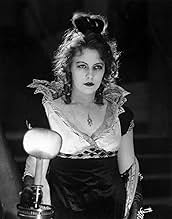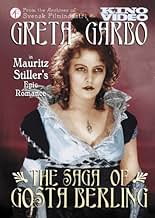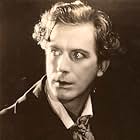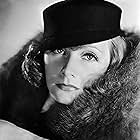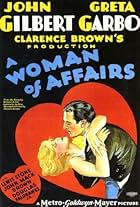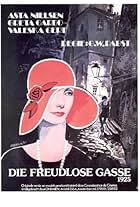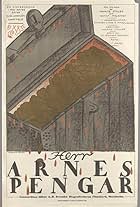IMDb RATING
7.0/10
1.4K
YOUR RATING
A drunkard priest who has been cast out by his community struggles to atone and regain his honour and dignity.A drunkard priest who has been cast out by his community struggles to atone and regain his honour and dignity.A drunkard priest who has been cast out by his community struggles to atone and regain his honour and dignity.
Gerda Lundequist
- Majorskan - Margaretha Samzelius
- (as Gerda Lundeqvist)
Karin Swanström
- Gustafva Sinclaire
- (as Karin Svanström)
Hilda Forsslund
- Modern (mother)
- (as Hilde Forslund)
Anna-Lisa Baude
- Märtha Dohnas Kammrrjungfrau
- (uncredited)
- Director
- Writers
- All cast & crew
- Production, box office & more at IMDbPro
Storyline
Did you know
- TriviaThe film was originally released as two parts in Sweden: "Gösta Berlings saga I" on 10 March 1924 and "Gösta Berlings saga II" seven days later. The two-part version was also used in Finland and Norway, but for the rest of the world a shorter, one-part export version was made.
- GoofsThe 1920s Soviet Russian film poster says 'Hans Larson' (Gans Larson) instead of Lars Hanson.
- Quotes
Opening Title Card: O Värmland, lovely land that you are, with your glittering lakes and distant blue mountains, your deep forests and lively streams! Come with us to the heart of that land!
- ConnectionsFeatured in Jazzgossen (1958)
- SoundtracksMy Heart Belongs To You
Music & Lyrics by Guy K. Austin
Featured review
The golden age of Swedish cinema (1913-1924) and the rapid growth in Svensk Filmindustrie were influenced by the works of two directors still remembered among many movie buffs today: Victor Sjostrom and Mauritz Stiller. They made a primary contribution to early films' style and, more importantly, their careers spread to Hollywood in the first half of the 1920s. Most importantly, both of them based some of their works on the source novels by Selma Lagerlof, a Nobel Prize Winner, an eminent figure in the Sweden of the early 20th century, a muse of Swedish silent cinema. However, the directors' results from the cooperation with the eminent author were quite opposing.
While Sjostrom, as a typical diligent Swede, won Lagerlof's heart (his timeless THE PHANTOM CARRIAGE), Stiller was not so successful being nearly 'persona non grata' due to his 'liberal attitude' towards the source materials (he tried to interpret it rather than film it). Even the adaptation of her GUNNAR HEDE'S SAGA did not meet with the author's enthusiasm. Therefore, the task to film GOSTA BERLINGS SAGA occurred a hard venture because Stiller had an investigating approach, his directorial attempts were loose, he changed some parts of the storyline, some characters for the sake of the new phenomenon that cinema was. That is the very basic fact about his GOSTA BERLINGS SAGA. Consequently...the strong points of the movie do not, indeed, lie in the faithfulness to the novel but elsewhere...
At first, it is important to note that for many years the film has been viewed on weak copies, which resulted in serious shortcomings within critical reviews. The new formidably restored Kino version (which I had pleasure to see during its premiere on Polish TV on two consecutive frosty evenings) with the lovely musical score recaptures its potential and makes this silent film not only 'endurable' but overwhelming and unforgettable. No doubt many reviewers find the restored version much more appealing. But where does the film's popularity lie?
For many, the film is remembered merely as Stiller's radiant discovery: Greta Gustafsson later known to the world as Greta Garbo. And, as a Garbo fan, I admit that knowing Greta Garbo's films without seeing GOSTA BERLINGS SAGA equals to having an apple tree in the garden and not tasting its apples. It is a must to see Garbo in this role of Elizabeth Dohna: a young, still inexperienced newcomer under the constant dominance of her tutor Mauritz Stiller from the time when, as some of her biographers say, in order to shape her, it was enough for the director to look into her eyes... Yes, Stiller noticed something unique in her and brought it out, to the light of camera. And there are some lovely scenes that capture her radiance, including the first close-up in the sleigh sequence, Garbo picking flowers in the garden and walking downstairs in shadowy interiors. However, the specific feature of the movie is its episodic structure and, what results from it, its numerous characters. In that way, saying that the film is worth seeing due to Garbo would be an unforgivably limited view. The film is a lovely representation of various characters and their lives in the 19th century Sweden. Those truly unique performances are handled by Lars Hanson and, above all, GERDA LUNDEQUIST!
Lars Hanson, a mainstay in Stiller's movies before leaving for Hollywood, gives a captivating performance here as a 'defrocked man of God' depicting his character's frustration, guilt, even curse and constant search for redemption. His wandering from the priest through a tutor, then one of the cavalier fellows to the owner of new Ekeby is filled with breathtaking moments. Women he loves disappear, things he owns gradually decline and nothing seems to be left at certain moments. However, a truly haunting part is portrayed by Sweden's Sarah Bernhardt - Gerda Lundequist as Margaretha Samzelius, the 'Majorskan.' With lots of flashbacks, the vibrant and subtle interpretation of her character leaves a viewer stunned. Perhaps the most memorable factor of her plot is the mother-daughter relation and her mother's curse she strives to get cleaned. Characters have much in common with one another (this aspect of the family relations is also developed in Marianne Sinclair's plot). Among the supporting cast, Karin Swanstrom as Gustave Sinclair and Ellen Hartman-Cederstrom as Martha Dohna are worth noticing, particularly due to the striking features of different female characters.
But what primarily makes GOSTA BERLINGS SAGA a captivating experience are its visuals. Great credit to the terrific cinematographer Julius Jaenzon. The picturesque depiction of Swedish climate and its idyllic landscape (many scenes depict the peaceful images of snow), the artistic use of light and shadow in the interior shots, the elaborate sets and bizarre wardrobe make many scenes real feast for the eyes. Top notch art direction by Vilhelm Bryde! Mind you that clothes are the undertone of characters' features (Martha Dohna with her peacock's dresses and weird hairstyle). The most memorable scenes of the film include the fire at the Ekeby Mansion (in particular Gosta saving the life of Marianne Sinclair), the famous Elizabeth/Gosta's sleigh scene on frozen Lake Lofven (consider the wolves and the formidable final shot of this sequence), Margaret Celsing approaching the house of her mother, Marianne Sinclair knocking at the door of her home, Gosta and his sermon, the banquet at Ekeby and the unforgettable finale at Broby Inn and new Ekeby.
The only flaw that does not allow the film be labeled as 'masterpiece' is its continuity caused by editing and shortening of scenes.
Much more could be said about 'Sweden's GONE WITH THE WIND.' It was a great surprise for me to see it in its restored version with the voice over that helped me follow the plots. A highly riveting silent movie, not merely for Greta Garbo fans. Intensely beautiful symphony of cinema with visual splendor! 9/10
While Sjostrom, as a typical diligent Swede, won Lagerlof's heart (his timeless THE PHANTOM CARRIAGE), Stiller was not so successful being nearly 'persona non grata' due to his 'liberal attitude' towards the source materials (he tried to interpret it rather than film it). Even the adaptation of her GUNNAR HEDE'S SAGA did not meet with the author's enthusiasm. Therefore, the task to film GOSTA BERLINGS SAGA occurred a hard venture because Stiller had an investigating approach, his directorial attempts were loose, he changed some parts of the storyline, some characters for the sake of the new phenomenon that cinema was. That is the very basic fact about his GOSTA BERLINGS SAGA. Consequently...the strong points of the movie do not, indeed, lie in the faithfulness to the novel but elsewhere...
At first, it is important to note that for many years the film has been viewed on weak copies, which resulted in serious shortcomings within critical reviews. The new formidably restored Kino version (which I had pleasure to see during its premiere on Polish TV on two consecutive frosty evenings) with the lovely musical score recaptures its potential and makes this silent film not only 'endurable' but overwhelming and unforgettable. No doubt many reviewers find the restored version much more appealing. But where does the film's popularity lie?
For many, the film is remembered merely as Stiller's radiant discovery: Greta Gustafsson later known to the world as Greta Garbo. And, as a Garbo fan, I admit that knowing Greta Garbo's films without seeing GOSTA BERLINGS SAGA equals to having an apple tree in the garden and not tasting its apples. It is a must to see Garbo in this role of Elizabeth Dohna: a young, still inexperienced newcomer under the constant dominance of her tutor Mauritz Stiller from the time when, as some of her biographers say, in order to shape her, it was enough for the director to look into her eyes... Yes, Stiller noticed something unique in her and brought it out, to the light of camera. And there are some lovely scenes that capture her radiance, including the first close-up in the sleigh sequence, Garbo picking flowers in the garden and walking downstairs in shadowy interiors. However, the specific feature of the movie is its episodic structure and, what results from it, its numerous characters. In that way, saying that the film is worth seeing due to Garbo would be an unforgivably limited view. The film is a lovely representation of various characters and their lives in the 19th century Sweden. Those truly unique performances are handled by Lars Hanson and, above all, GERDA LUNDEQUIST!
Lars Hanson, a mainstay in Stiller's movies before leaving for Hollywood, gives a captivating performance here as a 'defrocked man of God' depicting his character's frustration, guilt, even curse and constant search for redemption. His wandering from the priest through a tutor, then one of the cavalier fellows to the owner of new Ekeby is filled with breathtaking moments. Women he loves disappear, things he owns gradually decline and nothing seems to be left at certain moments. However, a truly haunting part is portrayed by Sweden's Sarah Bernhardt - Gerda Lundequist as Margaretha Samzelius, the 'Majorskan.' With lots of flashbacks, the vibrant and subtle interpretation of her character leaves a viewer stunned. Perhaps the most memorable factor of her plot is the mother-daughter relation and her mother's curse she strives to get cleaned. Characters have much in common with one another (this aspect of the family relations is also developed in Marianne Sinclair's plot). Among the supporting cast, Karin Swanstrom as Gustave Sinclair and Ellen Hartman-Cederstrom as Martha Dohna are worth noticing, particularly due to the striking features of different female characters.
But what primarily makes GOSTA BERLINGS SAGA a captivating experience are its visuals. Great credit to the terrific cinematographer Julius Jaenzon. The picturesque depiction of Swedish climate and its idyllic landscape (many scenes depict the peaceful images of snow), the artistic use of light and shadow in the interior shots, the elaborate sets and bizarre wardrobe make many scenes real feast for the eyes. Top notch art direction by Vilhelm Bryde! Mind you that clothes are the undertone of characters' features (Martha Dohna with her peacock's dresses and weird hairstyle). The most memorable scenes of the film include the fire at the Ekeby Mansion (in particular Gosta saving the life of Marianne Sinclair), the famous Elizabeth/Gosta's sleigh scene on frozen Lake Lofven (consider the wolves and the formidable final shot of this sequence), Margaret Celsing approaching the house of her mother, Marianne Sinclair knocking at the door of her home, Gosta and his sermon, the banquet at Ekeby and the unforgettable finale at Broby Inn and new Ekeby.
The only flaw that does not allow the film be labeled as 'masterpiece' is its continuity caused by editing and shortening of scenes.
Much more could be said about 'Sweden's GONE WITH THE WIND.' It was a great surprise for me to see it in its restored version with the voice over that helped me follow the plots. A highly riveting silent movie, not merely for Greta Garbo fans. Intensely beautiful symphony of cinema with visual splendor! 9/10
- marcin_kukuczka
- Jan 28, 2012
- Permalink
- How long is The Saga of Gösta Berling?Powered by Alexa
Details
- Runtime3 hours 3 minutes
- Color
- Sound mix
- Aspect ratio
- 1.33 : 1
Contribute to this page
Suggest an edit or add missing content

Top Gap
By what name was The Saga of Gösta Berling (1924) officially released in Canada in English?
Answer

